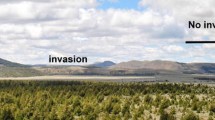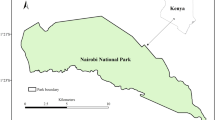Abstract
In the 1950s Charles Elton hypothesized that more diverse communities should be less susceptible to invasion by exotic species (biodiversity–invasibility hypothesis). The biodiversity–invasibility hypothesis postulates that species-rich communities are less vulnerable to invasion because vacant niches are less common and the intensity of interspecific competition is more severe. Field studies were conducted at two sites, a logged site and an unlogged site in Santa Rosa County, Florida, U.S.A, to test Elton’s hypothesis using cogongrass (Imperata cylindrica), a non-indigenous grass invading large areas of the Southeastern United States. The logged site was under 17-year-old loblolly pine prior to clear cutting. The unlogged site, a longleaf pine forest, was at the Blackwater River State Forest. Both the logged site and unlogged site showed no significant relationship between the rate of cogongrass spread and native plant species richness, functional richness, and cover of the invaded community. Increased species or functional richness may increase the use of resources; however, the extensive rhizome/root network possessed by cogongrass and its ability to thrive under shade may allow for its persistence in a diverse community. The results from both the logged and unlogged sites do not support the general hypothesis of Elton that invasion resistance and compositional stability increase with diversity. Biodiversity does not appear to be an important factor for cogongrass invasion in the southern United States. Extrinsic factors in this study prevent the ability to draw a defined causal relationship between native plant diversity and invasibility. Underlying reasons for why no relationship was observed may be simply due to the tremendous competitive ability of cogongrass or the narrow range of species richness, functional richness and cover observed in our study.






Similar content being viewed by others
References
Burke MJ, Grime JP (1996) An experimental study of plant community invasibility. Ecology 77:776–790
Crawley MJ, Brown SL, Heard MS, Edwards GR (1999) Invasion-resistance in experimental grassland communities: species richness or species identity? Ecol Lett 2:140–148
Dozier H J, Gaffney F, McDonald SK, Johnson ERRL, Shilling DG (1998) Cogongrass in the United States: history, ecology, impacts and management. Weed Tech 12:737–743
Dukes JS (2001) Biodiversity and invasibility in grassland microcosms. Oikos 126:563–568
Dukes JS (2002) Species composition and diversity affect grassland susceptibility and response to invasion. Ecol Appl 12:602–617
Elton CS (1958) The ecology of invasions by animals and plants. T. Methuen and Co., London
English R (1998) The regulations of axillary bud development in the rhizomes of cogongrass (Imperata cylindrica (L.) Beauv.). Ph.D. Dissertation, University of Florida, Gainesville, FL
Eussen JHH (1980) Biological and ecological aspects of alang–alang [Imperata cylindrica (L.) Beauv.]. In: Proceedings of BIOTROP workshop on alang–alang in Bogor, 27–29 July 1976. Biotropica Special Pub. No. 5 Bogor, Indonesia, pp 15–22
Fargione J, Brown CS, Tilman D (2003) Community assembly and invasion: an experimental test of neutral vs. niche processes. PNAS 100:8916–8920
Foster BL, Smith VH, Dickson TL, Hildebrand T (2002) Invasibility and compositional stability in a grassland community: relationships to diversity and extrinsic factors. Oikos 99:300–307
Hobbs RJ, Huenekke LF (1992) Disturbance, diversity and invasion: implications for conservation. Conser Biol 6:324–337
Hooper DU (1998) The role of complementarity and competition in ecosystem responses to variation in plant diversity. Ecology 68:704–719
Hooper DU, Vitousek PM (1998) Effects of plant composition and diversity of nutrient cycling. Ecol Monogr 68:121–149
Hubbard CE, Brown D, Gray AP, Whyte RO (1944) Imperata cylindrica: taxonomy, distribution, economic significance and control.Imperial Agricultural Bureau Joint Publication 7
Jose S, Cox J, Miller DL, Shilling DG, Merritt S (2002) Alien plant invasions in southeastern forests. The story of cogongrass. J For 100:41–44
Kennedy TA, Naeem S, Howe KM, Knops JMH, Tilman D, Reich P (2002) Biodiversity as a barrier to ecological invasion. Nature 417:636–638
Knops JMH, Tilman D, Haddad NM, Naeem S, Mitchell CE, Haarstad J, Ritchie ME, Howe KM, Reich PB, Siemann E, Groth J (1999) Effects of plant species richness on invasion dynamics, disease outbreaks, insect abundances, and diversity. Ecol Lett 2:286–293
Lavorel S, Prieur-Richard AH, Grigulis K (1999) Invasibility and diversity of plant communities: from patterns to process. Diver Distr 5:41–49
Levine JM (2000) Species diversity and biological invasions: relating local process to community pattern. Science 288:852–854
Lodge DM (1993) Biological invasions: lessons for ecology. Trends Ecol Evol 8:133–137
Lonsdale WM (1999) Global patterns of plant invasions and the concept of invasibility. Ecology 80:1522–1536
MacDonald GE (2004) Cogongrass (Imperata cylindrica) – biology, ecology and management. Critic Rev Plant Sci 23:367–380
McGrady-Steed J, Harris PM, Morin PJ (1997) Biodiversity regulates ecosystem predictability. Nature 390:162–165
McIntyre S, Ladiges PY, Adams G (1998) Plant species richness and invasion by exotics in relation to disturbance of wetland communities on the Riverine Plain, NSW. Aust J Ecol 13:361–373
McKinney ML (2001) Effects of human population, area, and time on non-native plant and fish diversity in the United States. Biol Conserv 100:243–252
Naeem S, Wright JP (2003) Disentangling biodiveristy effects on ecosystem functioning: deriving solutions to a seemingly insurmountable problem. Ecol Lett 6:567–579
Naeem S, Knops JMH, Tilman D, Howe KM, Kennedy T, Gale S (2000) Plant diversity increases resistance to invasion in the absence of co varying extrinsic factors. Oikos 91:97–108
Palmer MW, Maurer T (1997) Does diversity beget diversity? A case study of crops and weeds. J Veg Sci 8:235–240
Prieur-Richard AH, Lavorel S (2000) Invasions: the perspective of diverse plant communities. Austral Ecol 25:1–7
Prieur-Richard AH, Lavorel S, Grigulis K, Dos Santos A (2000) Plant community diversity and invisibility by exotics: invasion of Mediterranean old fields by Conyza bonariensis and Conyza canadensis. Ecol Lett 3:412–422
Pyšek P, Jarošík V, Kučera T (2002) Patterns of invasion in temperate nature reserves. Biol Conserv 104:13–24
Ramsey CL, Jose S, Cox J, Miller DL, Shilling DG, Portier K, Merritt S (2003) Cogongrass [Imperata cylindirca (L.) Beauv.] response to herbicides and disking on a cutover site and in a mid-rotation pine plantation in southern USA. For Ecol Manage 179:195–207
Rejmanek M (1989) Invasibility of plant communities. In: Drake JA, Mooney HA, di Castri F, Groves RH, Kruger FJ, Rejmanek M, Williamson M (eds) Biological invasions: a global perspective. John Wiley & Sons, Brisbane, Australia, pp 369–388
Rejmanek M (1996) Species richness and resistance to invasions. In: Orians GH, Dirzo R, Cushman JH (eds) Biodiversity and ecosystem processes in tropical forests. Springer, Berlin, pp 153–172
Robinson GR, Quinn JF, Stanton ML (1995) Invasibility of experimental habitat islands in a California winter annual grassland. Ecology 76:786–794
SAS Institute (2002) SAS user’s guide, 9th edn. SAS Institute, Cary, NC
Seabloom EW, Dobson AP, Stoms SM (2003) Abiotic and biotic constraints on invasions: Vascular plants in California. Ecology Society of America Annual Meeting Abstracts 88:303–304
Stohlgren TJ, Binkley D, Chong GW, Kalkhan MA, Schell LD, Bull KA, Otsuki Y, Newman G, Bashkin M, Son Y (1999) Exotic plant species invade hot spots of native plant diversity. Ecol Mono 69:25–46
Terry PJ, Adjers G, Akobundo IO, Anoka AU, Drilling ME, Tjitrosemito S, Utomo M (1997) Herbicides and mechanical control of Imperata cylindrica as a first step in grassland rehabilitation. Agrofor Syst 36:151–179
Tilman D (1997) Community invasibility, recruitment limitation, and grassland biodiversity. Ecology 78:81–92
Tilman D (1999) The ecological consequences of changes in biodiversity: a search for general principles. Ecology 80:1455–1474
Tilman D (2004) Niche tradeoffs, neutrality, and community structure: a stochastic theory of resource competition, invasion, and community asembly. PNAS 101:10854–10861
Von Holle B (2005) Biotic resistance to invader establishment of a southern Appalachian plant community is determined by environmental conditions. J Ecol 93:16–26
Willard TR, Hall DW, Shilling DG, Lewis JA, Currey WL (1990) Cogongrass (Imperata cylindrica) distribution on Florida highway rights-of-way. Weed Technol 4:658–660
Acknowledgements
The authors express their sincere thanks to Drs. Francis E. Putz, Barry Brecke, Gregory MacDonald and Deborah L. Miller and an anonymous reviewer for their critical review of an earlier version of the manuscript. Funding provided by International Paper, Plum Creek Timber Company and the Institute of Food and Agricultural Sciences is greatly appreciated.
Author information
Authors and Affiliations
Corresponding author
Rights and permissions
About this article
Cite this article
Collins, A.R., Jose, S., Daneshgar, P. et al. Elton’s hypothesis revisited: an experimental test using cogongrass. Biol Invasions 9, 433–443 (2007). https://doi.org/10.1007/s10530-006-9050-4
Received:
Accepted:
Published:
Issue Date:
DOI: https://doi.org/10.1007/s10530-006-9050-4




